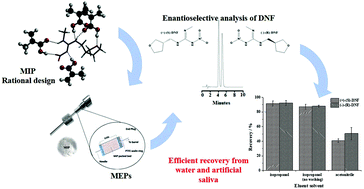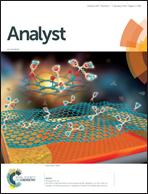Rational design of a molecularly imprinted polymer for dinotefuran: theoretical and experimental studies aimed at the development of an efficient adsorbent for microextraction by packed sorbent†
Abstract
In this work, we studied theoretically the formation process of a molecularly imprinted polymer (MIP) for dinotefuran (DNF), testing distinct functional monomers (FM) in various solvents through density functional theory calculations. The results revealed that the best conditions for MIP synthesis were established with methacrylic acid (MAA) as FM in a 1 : 4 stoichiometry and with chloroform as the solvent. This protocol showed the most favourable stabilization energies for the pre-polymerization complexes. Furthermore, the formation of the FM/template complex is enthalpy driven and the occurrence of hydrogen bonds between the DNF and MAA plays a major role in the complex stability. To confirm the theoretical results, MIP was experimentally synthesized considering the best conditions found at the molecular level and characterized by scanning electron microscopy and thermogravimetric analysis. After that, the synthesized material was efficiently employed in microextraction by packed sorbent combined with high-performance liquid chromatography in a preliminary study of the recovery of DNF from water and artificial saliva samples.

- This article is part of the themed collection: Analyst Recent HOT articles


 Please wait while we load your content...
Please wait while we load your content...